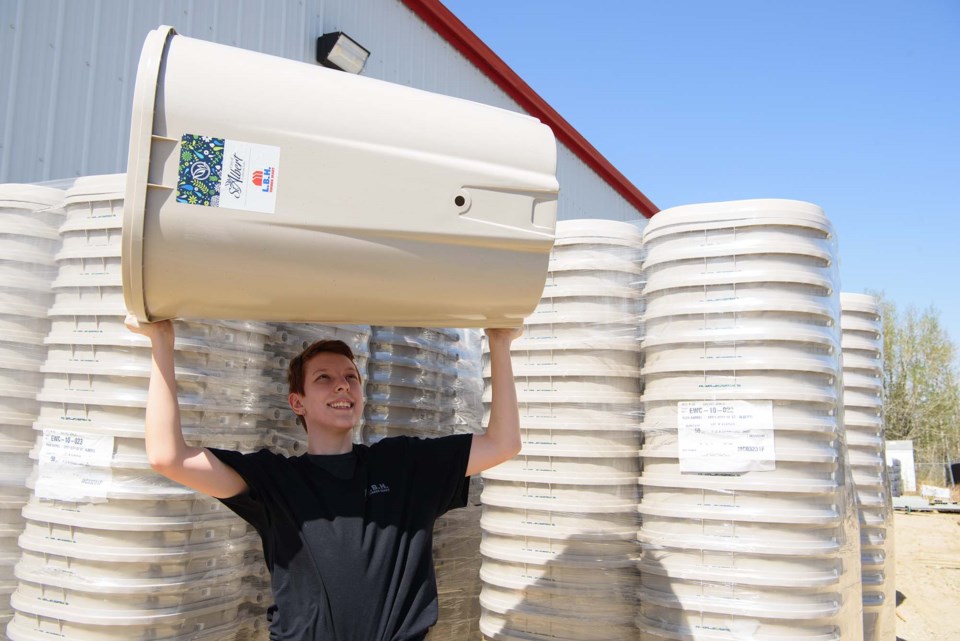Correction
This story originally said that intermediate bulk containers were typically used to ship food. They are in fact typically used for liquids. The device that diverts the first debris-laden flush of water away from a rain barrel is also called a first flush-diverter, not a first-flood diverter. The Gazette apologizes for these errors.
This Green House
The Gazette is taking a close look at how to improve your home to guard against climate change. Got a question on climate mitigation? Send it to [email protected] to be answered in a future column.
St. Albert was a dry, hot place prior to last week, which had many farmers (and firefighters) praying for rain. We got some, but most of it ran off our roofs down the drain. If only we could have saved some for later...
Last winter, This Green House looked at how to cut your home’s carbon footprint with the help of the Clean Energy Improvement Program.
But even if we stopped all greenhouse gases today, we’d still face a warmer, wilder climate in the years ahead, one where droughts and wildfires like the ones ravaging Alberta right now will be more common. We need to act today to adapt our homes to these new climate challenges.
Over the next few months, This Green House will look at what St. Albert residents can do to adapt their homes to climate change. We’ll start with a perennial spring problem: drought.
Catch it
St. Albert will likely have nearly eight times as many +30 C days a year by the 2060s than it does today due to global heating, the St. Albert Climate Adaptation Plan reports. We’ll get a bit more precipitation each year (about 11 per cent), but those rains will be more sudden, with heavy precipitation days rising by about 30 per cent.
The upshot of all this is drier summers and more rain and snow in short bursts, said Sturgeon County permaculture expert Kenton Zerbin.
“Keeping water around your property longer is going to be instrumental in keeping a thriving yard,” he said.
Rain barrels are an excellent way to do so, Zerbin said. By catching water from your roof, you can have water available to irrigate your lawn and put out fires.
A typical 200 L rain barrel (similar to the one available through the City of St. Albert’s annual rain barrel sale, which is this May 13) should provide homeowners with enough water for a small garden, Zerbin said. If you have a big lawn, consider an intermediate bulk container, AKA those big plastic tanks you see at the truck fill stations. Typically used to ship liquids, these containers store up to 1,000 L of water and often come with a metal cage that can double as a trellis for your peas to climb. Be sure you get a food-grade one, though, as these containers are sometimes used to ship toxic chemicals.
“Water off our roof is going to be dirty,” Zerbin said, and full of leaves, sticks, and bird poop.
A leaf-eater (a slanted metal screen) can intercept this debris, while a first-flush diverter (a pipe with a floating ball in it) can redirect it by diverting that first debris-laden rush of water away from your barrel. Zerbin said you can make these devices yourself or buy them pre-made.
City of St. Albert environment co-ordinator Payton Homeak said a good rain barrel should have a lid to keep out bugs and children and an overflow hose to keep water away from your foundations. Be sure to drain, cover, and flip over your barrel during freezing conditions to keep it from cracking.
Use less of it
Homeowners can also use water more efficiently. Water during the cool evenings and mornings to reduce evaporation, and use a hose or can instead of a sprinkler, Homeak said. (It’s illegal to water your lawn in St. Albert between 9 a.m. and 7 p.m. between May 1 and Oct 1.) Cut your grass to eight centimetres tall to retain more water, and only water your lawn for about an hour a week.
You can also xeriscape your lawn to use less water, said St. Albert-area gardening guru Jim Hole. This means replacing grass and flowers with water-saving plants such as hens and chicks, feather reed grass, prickly pear cactus, and yucca.
“I’ve got a yucca in my front yard — a hardy one, obviously — and I think I watered it once about 10 years ago. That was it,” Hole said.
You won’t get blooms year-round with xeriscaping, but your lawn will take a lot less mowing and watering, Hole said.
“You can comfortably walk away or go on holiday without having someone water your garden because it’s going to be just fine when you get back.”
If it’s super-hot and dry out, it’s often best to not water your lawn as much and accept that it won’t look pristine, Hole said.
“Tough it out and leave it.”
Mulch, trees, and awnings can reduce water losses from your yard while providing more shade, saving you money and guarding against drought, Zerbin said.
“You’re going to have a more successful yard that you’re going to enjoy and your plants are going to enjoy.”
The City of St. Albert’s annual rain barrel sale starts at 8:30 a.m. this May 13 at the L.B.H. Building Centre on Riel Drive. Move fast if you want one: with just 600 available at $65 each, Homeak said these barrels will probably be sold out by noon.




